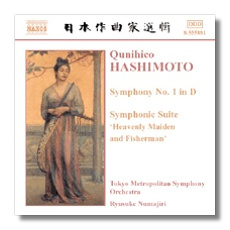
The Internet's Premier Classical Music Source
Related Links
- Latest Reviews
- More Reviews
-
By Composer
-
Collections
DVD & Blu-ray
Books
Concert Reviews
Articles/Interviews
Software
Audio
Search Amazon
Recommended Links
Site News
 CD Review
CD Review
Qunihico Hashimoto

- Symphony #1 in D Major
- Symphonic Suite "Heavenly Maiden and Fisherman"
Tokyo Metropolitan Symphony Orchestra/Ryusuke Numajiri
Naxos 8.555881 DDD 67:03
With the exception of Takemitsu and Mayazumi, Japanese classical composers are not widely known in the West. In the past, collectors who were more than just superficially curious about this repertoire usually were forced to collect hard-to-find and expensive discs exported from Japan. Naxos is making things a lot easier and cheaper with its series of Japanese classics, of which this is the latest release.
Qunihico Hashimoto was born in Tokyo in1904. As a composer, he was largely self-taught, although he had extensive formal musical training as a conductor, pianist, and violinist. Hashimoto incorporated musical influences as disparate as Impressionism, jazz, and traditional Japanese music. In the mid 1930s, he went to Europe to study, returning to his homeland just in time for World War Two. While Japan's fortunes looked good, he wrote his share of tub-thumping patriotic works. After the war, however, he shared in the disillusion of many of his countrymen, and he died of cancer at the pathetically early age of 44.
The First Symphony was written in 1940. (A Second Symphony dates from the post-war years.) The occasion was the 2600th anniversary of the Japanese emperor, and other composers also got into the act, including Richard Strauss. Hashimoto intentionally wrote a traditional symphony that would be approachable to the untrained listener, and that would make him or her feel good about Japan and the new directions in which it was going. Like Khachaturian, Hashimoto succeeded quite well at keeping the powers-that-be happy without selling himself out. Western and Eastern influences mix comfortably in this symphony. The middle movement is particularly attractive; Hashimoto takes a Japanese theme and repeats it, Boléro -style, with steadily mounting intensity and orchestral heft. The finale – a theme, eight variations, and a fugue – is based on a traditional Japanese song. Although there are many Japanese elements in this work, its colors, development, and orchestration seem very typical of what was going on in the West earlier in the 20th century.
Hashimoto wrote several ballets earlier in his career. Heavenly Maiden and Fisherman was premièred in 1932. It is based on the ancient Japanese story of a celestial being whose magic robe is stolen by a mortal. She marries him, but at the end of ballet she recovers her robe and returns to heaven, ditching her clay-footed husband. The suite assembled here contains seven numbers and abridges the ballet's plot neatly. Here, I found Hashimoto's music to be as Eastern European in flavor as it is Western. I heard hints of Szymanowski and early Scriabin in this score, and also of Debussy's contemporaries, including Roussel and Pierné.
The performances might be a little more assertive, but I expect they reveal what these works have to offer more than adequately. Naxos' engineering gives this colorful music the assistance it deserves.
Copyright © 2003, Raymond Tuttle


















